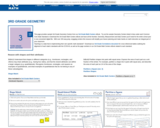
Great for math centers that align with the 3rd grade Geometry unit!
- Subject:
- Geometry
- Mathematics
- Material Type:
- Activity/Lab
- Author:
- © 2010 - 2019 K-5 Math Teaching Resources LLC
- Date Added:
- 07/29/2019

Great for math centers that align with the 3rd grade Geometry unit!

Students use fraction pieces to model the addition of fractions with like denominators and draw a model to justify their answers.

Students decompose numbers less than or equal to 10 into pairs in more than one way by using objects or drawings, and they will record each decomposition by a drawing or equation (e.g. 5= 2 + 3 and 5 = 4+1).

Students work with a partner and sit opposite one another with a divider between them. Each student takes turns drawing and labeling angles in each space on their grids and give instructions to their partner on how to draw the angles to match the ones on his/her grid. Students use positional language to describe where to place the angles.

Students roll a die and divide circles into the number of equal sections shown on the die. They explain how measuring the first angle helped them to find the measurement of other angles in each circles.

Students are given a scenario and must select three rectangles to show how they could use Jack's strategy of breaking apart a rectangle to find the area of each figure.

Students explore equivalent fractions using a game. Using a deck of cards, students pick a fraction and initial a brick. Play continues until one students has initial 5 rows of bricks.

Students work in small groups to build one 1m by 1m squares using newspaper. The groups combine to construct a cube. The students then fill the cubes with base 10 cubes, longs and flats.

Students work with a partner to build a train using snap cubes of the same color and determine the number of tens and ones they have. Students draw the train to show how they counted the cubes.

Students compare two decimals to hundredths by reasoning about their size, recognize that comparisons are valid only when the two decimals refer to the same whole, and record the results of comparisons with the symbols >, <, or =.

Students work with a partner to make a coordinate grid by using a dry erase marker to number the x-axis and y-axis on a Geoboard. One partner creates a polygon on the Geoboard using a rubber band and names the coordinates of the vertices while the other partner plots the points on coordinate grid paper and connects the points with line segments. They will compare the picture to the polygon on the Geoboard and discuss any differences.

Students choose three rectangles and cover them with color tiles. Students record their work explaining how many color tiles they used to partition each rectangle into rows and columns. Lastly, students write an equation to represent the number of color tiles in each row and the total number of squares used to cover each rectangle.

Students use the data in the table to create a bar graph in this interactive resource. Students mouse over the columns on the graph in order to display the data correctly on the bar graph.

Students design two possible enclosures for a zoo animal with an area of 40 square meters and tell which enclosure they think would be most suitable for the zoo animal students chose.

Students write a story to illustrate problems and determine each quotient using a diagram. Students use multiplication and division to check their work.

Students learn to divide by using the partial products strategy, using a 3 digit number divided by a 1 digit number.

Students solve addition and subtraction word problems, and add and subtract within 10, e.g. by using objects or drawings to represent the problem.

Students spin two numbers and write a multiplication sentence, using the doubling and halving strategy to compute the product.

Students estimate the quotient of a 3 digit number by a 1 digit number.

Students work with a partner to estimate and measure the weight of a set of small classroom objects and record their findings on a chart.